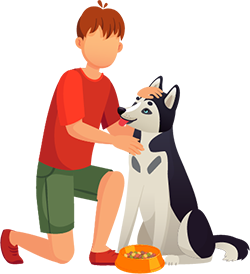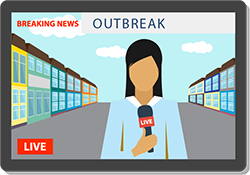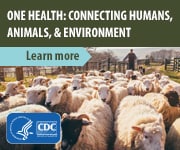Solving Outbreaks Linked to Contact with Animals
Learn how public health and animal health officials work together to solve outbreaks linked to animal contact and protect the public.
Animal contact outbreaks happen when germs from animals make people sick.
Animals sometimes carry germs that can make people sick, even when they look healthy and clean. Some examples of animal-related germs that can make people sick are Salmonella, E. coli, leptospirosis, rat-bite fever, and hantaviruses.
People can get sick from animals in several ways:

- Touching animals, including their waste (poop and pee) and body fluids (blood, tears, sweat, and saliva)
- Touching animal products or supplies like pet food or treats
- Touching anything in areas where animals live or roam
- Eating food or drinking water contaminated by animal waste or body fluids
- Breathing in germs from animals
Public health and animal health officials gather three types of information to solve outbreaks.
When an outbreak is detected, officials work quickly to collect as much information as possible to figure out what is making people sick. They gather four types of information (epidemiologic, traceback, trace forward, and testing) to answer the questions below. The more questions they can answer, the more likely they are to solve the outbreak.

Epidemiologic information
- Where and when did people get sick?
- Has the same germ caused outbreaks before? If it has, what made people sick in those outbreaks?
- What animals, items, or environments did sick people report contact with more often than healthy people?
- If there was contact with animals, were the animals wild or domesticated? Were the animals sick or healthy?
Traceback information
- Is there a common place where the animals or items could have gotten the germ that made people sick?
- Is there anything about the setting (for example, farms, factories, or pet and agriculture stores) that made germs likely to spread?
Trace forward information
- Were the animal products or supplies distributed to people or businesses?
- Are other people likely to have contact with the germ that made people sick?

Testing information
- Is the germ causing the outbreak also found in animals, their environment, or items that came in contact with the animals?
- Do the germs found in the animals, their environment, or items that came in contact with the animals have the same DNA fingerprints as germs found in sick people?
Officials take actions to protect the public when there is clear and convincing information showing that people in the outbreak got sick from contact with an animal or animal product.

- Public health officials warn the public about the outbreak and give advice on how to prevent the spread of germs between animals and people.
- Animal health and public health officials work with people who breed, raise, own, and sell animals to reduce the number of germs in the animals and their environment and to keep animal caretakers healthy.
- Companies recall contaminated pet foods or treats, and infected animals are removed from areas where people interact with animals (like a pet store or petting zoo).
